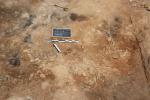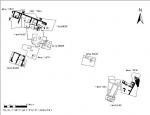Summary (English)
The third campaign of the Marzuolo Archaeological Project aimed to investigate the various craftworking productions in the north-western part of the site, in order to understand both the scale and nature of the productions and their infrastructures, and to generate a useful quantity of artefacts and production materials.
Two excavation areas were reopened (Fig. 1). A small trench was opened at the north edge of Area 10000 (excavated in 2012-2013) in order to finish the excavation of the stacks of Italian sigillata buried by the fire that destroyed the production area (Fig. 2). These stacks were partially uncovered at the end of 2012 (Roman Peasant Project), but its context remained unknown. The return to this area was able to associate the pottery deposit with the opus reticulatum structure to the north. The pottery was stacked on shelves (nails and hinges were found and their position registered) that were attached to the east face of the NE-SW wall, built with a cobblestone footing and plastered pisé walls. The later construction of the church cut the deposit. Another 150+ MNI ceramic vessels were recovered: each has been given a number, which corresponds with its position (allowing the reconstruction of the stacking of the vases). A study season will be dedicated to these materials in autumn 2019.
Area 17000 was also reopened. In this area, a trench was centred on a little-known room in the production complex, and a second trench continued the exploration of the so-called smith’s workshop. The excavation of the latter completed the exceptional series of iron tools (including a saw), and metal artefacts that were being worked/recycled. A campaign in 2019 will be dedicated to the study and conservation of these objects.
Two new areas were also opened, both extending the excavation of the opus reticulatum building, which has a back wall at least 31 m long. The plan of the complex was added to by the discovery of a carefully constructed channel, with tile covering, running along the back wall (fig. 3). The plan of Area 19000 did not replicate the large rooms opening onto a courtyard as documented to the east in Area 17000; instead, this area was occupied by a large quadrangular room. Unfortunately, the stratigraphy was only preserved at foundation level, and evidence was found that suggested the function of this sector.
Area 20000, on the east side of Area 17000, provided more information about the variety of productions that took place in this complex. In particular, the room immediately east of the forge had an opus signinum floor and at least two cylindrical tanks, also covered with opus signinum (fig. 4). The function of these structures remains unknown; it will be clarified in the future by the analysis of the opus signinum samples that were taken. The western half of the room will be excavated in the future in order to understand the size of this installation (in theory there is space for two more tanks of the same size). The excavation of Area 20000 provided important new stratigraphic and structural evidence for the chronology of the occupation of the opus reticulatum building, which underwent alterations during its life of just over two generations. These alterations offer a glimpse of how the artisans occupying this area worked.
- Astrid Van Oyen- Cornell University (US)
Director
- Astrid Van Oyen- Cornell University (US)
Team
- Anna Maria Mercuri-Università di Modena
- Rhodora Vennarucci- University of Arkansas (US)
- Gijs Tol- University of Melbourne (Australia)
Research Body
- Cornell University
Funding Body
- Loeb Classical Library Foundation






![Download [PDF]](/excavation/skins/fasti/images/results/download_sml.png)


